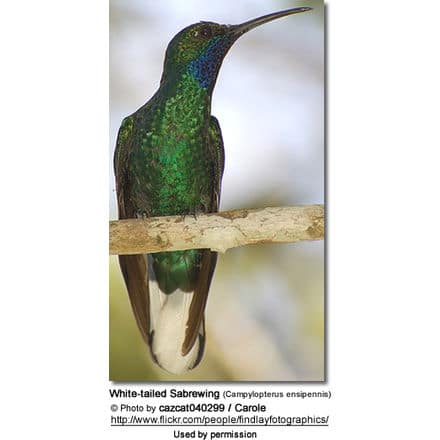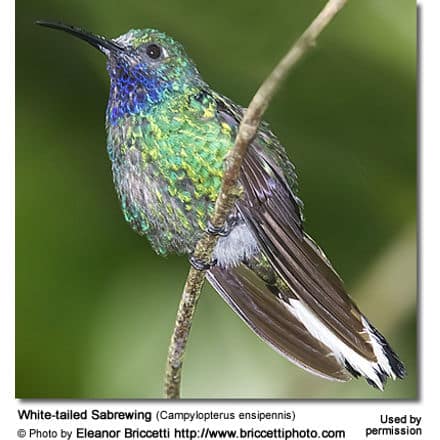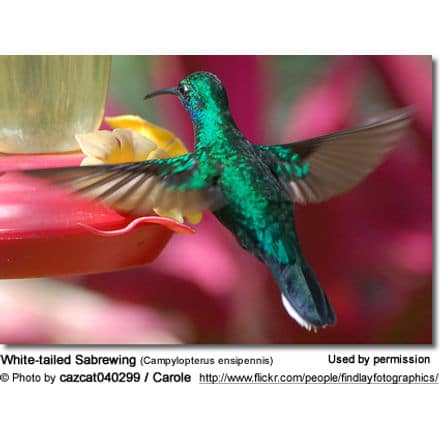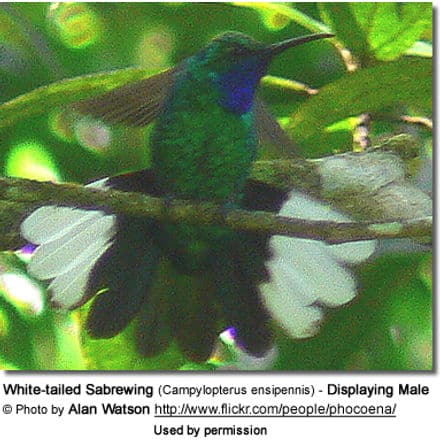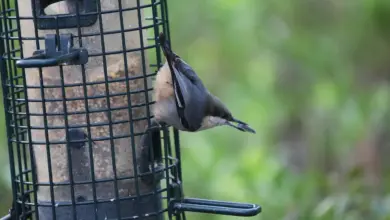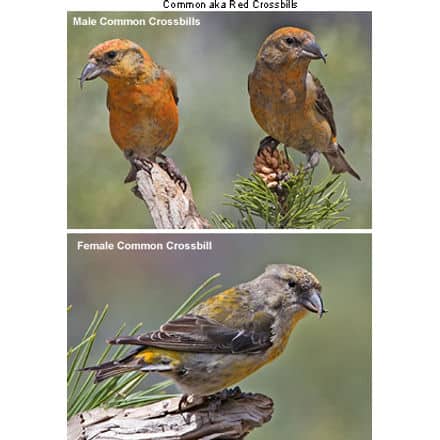White-tailed Sabrewings
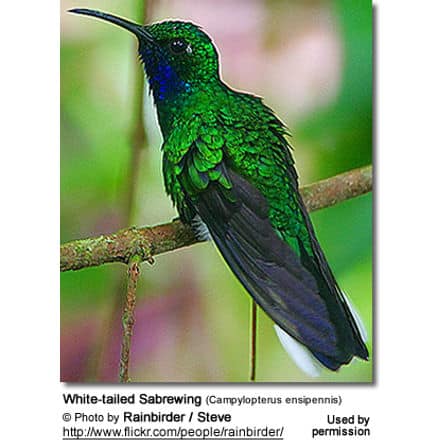
After Hurricane Flora destroyed most of its rainforest habitat on Tobago, the White-tailed Sabrewing was thought to be extinct on the island, but it was rediscovered in 1974. This species is now featured on Tobago’s environmental posters under the nickname “Campy”.
Alternate (Global) Names
Spanish: Ala de Sable de Cola Blanca, Colibrí Coliblanco … French: Campyloptère à queue blanche …Italian: Campilottero codabianca, Sciabolatore codabianca …German: Weißschwanz-Degenflügel … Czech: Kolibrík beloocasý, kolib?ík b?loocasý … Danish: Blåstrubet Sabelvinge …
Finnish: Muurahaissapelikolibri … Japanese: ojirokembanehachidori, ojirokenbanehachidori … Dutch: Witstaartsabelvleugel … Norwegian: Hvithalesabelvinge … Polish: zapylak bialosterny, zapylak bia?osterny … Russian: ??????????? ????????? … Slovak: kolibrík lesklý … Swedish: Blåstrupig sabelvinge
Distribution / Range
The White-tailed Sabrewings occur in …
- Northeastern Venezuela:
- Relatively common in shade coffee plantations on Cerro Negro and other parts of the Cordillera de Caripe (at 2,500 – 6,000 ft or 760 – 1,830 m) and mountains of Paria Peninsula (at 1,300 – 4,000 ft or 400-1,200 m) .
- Island of Tobago:
- The Main Ridge down to 300 ft or 100 m on the island of Tobago. Its former range (pre-hurricane) included south-west (Hillsborough Reservoir) and north-east (Pigeon Peak) areas of the islands – where populations don’t appear to have reestablished themselves after the severe weather event.It is estimated that between several hundred and in excess of 1,000 individuals still exist on Tobago.
Preferred Habitat: They mostly inhabit mature montane forests, regenerating forest less than 50 ft or 15 m tall; they occur along the edges of clearings, as well as in shade coffee and abandoned plantations.
Behavior: This species is known for being fearless and inquisitive. Male White-tailed Sabrewings typically perch conspicuously and defend their territories aggressively against other hummingbirds.
Description
The Sabrewings are very large compared to other hummingbirds. The White-tailed Sabrewing measures between 4.7 – 5.5 inches (12 – 14 cm) in length and weigh about 0.4 oz or 10 g.
The Sabrewings are named for their long, sabre-like outermost primary flight feathers, which are thickened, flattened and bent at an angle. Their black, strong bills are slightly down-curved. Females have longer bills.
The plumage is mostly green with distinctive white outer-tail feathers. Both males and females look alike, but the female is duller; males are generally larger than females, with longer tails and wings.
The three outer pairs of the tail feathers are white.
Adult Male: The male’s upper plumage is metallic golden-green. His chin and throat are glossy dark blue / violet. His wings are purplish-brown. He has a white spot next to his eyes. His bronze tail has two white markings on two-thirds of the three outer feathers. Adult males have widened ‘sabres’ (shafts of outermostprimary flight feathers) that are acquired during his second year.
Adult Female: The female is grey on the chest and abdomen; she has green markings on the sides. Only the center of the throat is blue.
Juveniles (younger than 1 year old) have tiny grooves on the bills.
Geographic Variations: The bill is generally longer in the Paria Peninsula population and the tail is usually shorter in the Cordillera de Caripe population.
Similar Species: Within its natural range, this is the only large hummingbird with white markings on the tail.
Calls / Vocalizations
The call is described as a repeated chirp. Males sing throughout the day usually while perched on mid-story branches. Their songs peak early morning and late afternoon.
Nesting / Breeding
The nesting season starts in January and goes on until April. However, breeding-age male Grey-breasted Sabrewings will display year-round in groups of up to 10 males (most often
2 to 4 males) at traditional leks (communal mating displays). The males will sing to the females and flash their sabres to gain their attention. They may fly in front of them in a u-shaped pattern. It is hypothesizes that females favor those males with the widest sabres. Up to 4 females visit these leks per day.
Hummingbirds in general are solitary and neither live nor migrate in flocks; and there is no pair bond for this species – the male’s only involvement in the reproductive process is the actual mating with the female.
The male will separate from the female immediately after copulation. One male may mate with several females. In all likelihood, the female will also mate with several males. The males do not participate in choosing the nest location, building the nest or raising the chicks.
The female White-tailed Sabrewing is responsible for building the large cup-shaped nest out of plant fibers woven together
and green moss on the outside for camouflage in a protected location in a shrub, bush or tree – often near water. She lines the nest with soft plant fibers, animal hair and feather down, and strengthens the structure with spider webbing and other sticky material, giving it an elastic quality to allow it to stretch to double its size as the chicks grow and need more room. The nest is typically found on a low, thin horizontal branch.
The average clutch consists of one white egg, which she incubates alone, while the male defends his territory and the flowers he feeds on. The young are born blind, immobile and without any down.
The female alone protects and feeds the chicks with regurgitated food (mostly partially-digested insects since nectar is an insufficient source of protein for the growing chicks). The female pushes the food down the chicks’ throats with her long bill directly into their stomachs.
As is the case with other hummingbird species, the chicks are brooded only the first week or two, and left alone even on cooler nights after about 12 days – probably due to the small nest size. The chicks leave the nest when they are about 20 days old.
Diet / Feeding
The White-tailed Sabrewings primarily feed on nectar taken from a variety of brightly colored, scented small flowers of trees, herbs, shrubs and epiphytes. They favor heliconia and banana flowers; but may also visit some flowers that open during the night for bats. They often feed on bromeliads in lower to middle strata.
They favor flowers with the highest sugar content (often red-colored and tubular-shaped) and seek out, and aggressively protect, those areas containing flowers with high energy nectar. They use their long, extendible, straw-like tongues to retrieve the nectar while hovering with their tails cocked upward as they are licking at the nectar up to 13 times per second. Sometimes they may be seen hanging on the flower while feeding.
Many native and cultivated plants on whose flowers these birds feed heavily rely on them for pollination. The mostly tubular-shaped flowers actually exclude most bees and butterflies from feeding on them and, subsequently, from pollinating the plants.
They may also visit local hummingbird feeders for some sugar water, or drink out of bird baths or water fountains where they will either hover and sip water as it runs over the edge; or they will perch on the edge and drink – like all the other birds;
however, they only remain still for a short moment.
They also take some small spiders and insects – important sources of protein particularly needed during the breeding season to ensure the proper development of their young. Insects may be caught in flight (hawking); snatched off leaves or branches, or are taken from spider webs. A nesting female can capture up to 2,000 insects a day.
Males tend to catch insects in mid-air (hawking); while females tend to glean insects them from vegetation.
Metabolism and Survival and Flight Adaptions – Amazing Facts
Status
The White-tailed Sabrewing is considered “Near Threatened” in its natural habitat.
In 1963, after hurricane Flora devastated the Caribbean islands, this species was thought to have become extinct in Tobago; but its population has now largely recovered.
Trail surveys found that the White-tailed Sabrewings are widely scattered from Mount Dillon in the west to Hermitage Hill in the east. They are either very rare or completely absent in parts of their former range.
Species Research by Sibylle Johnson
Please Note: The articles or images on this page are the sole property of the authors or photographers. Please contact them directly with respect to any copyright or licensing questions. Thank you.

